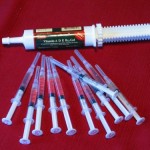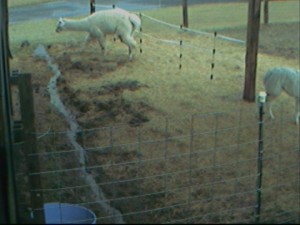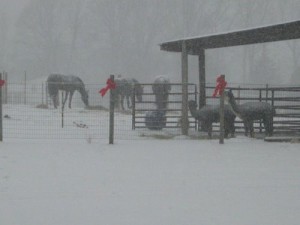
Today is the day of the month I feel like a junkie. Since I live in a region that has the meningeal worm my alpaca chores the first weekend of each month involves giving our alpacas a shot of Ivormec. My little cria Albina also got a booster of CD&T and some Vitamin A&D Paste today also.
I utilize my morning feeding routine to lock the alpacas in their run-ins. Surprisingly they know something is up even though it’s the same routine. Smart animals! While they are in munching away I head back inside to prepare all the syringes.
Ivormec is given at 1cc per 70lbs of body weight. It’s a good idea to know your alpaca’s weight so having a livestock scale is recommended. I don’t weigh and give shots on the same day. It seems to stress them out so usually I weigh them 1 or 2 weeks before hand to spread out the scary moments. I’ll often psych them out and sometimes lock them in just to give them treats and let them back out to keep them guessing but they always seem to know when I have other intentions.
I use a 20 gage, 3cc, 1 inch long needles for ivormec – I find the 22 gage is too small and it’s hard to draw.
NOTE: Mark the bottom of the plunger with the initials of the animal it’s going to
Preparing the Syringe:
· First wipe the top of the bottle off with alcohol to sterilize it.
· Draw back on the plunger
· Uncap the needle
· Insert the needle into the bottle and Depress the plunger adding air to the bottle
o Adding air makes it easier to draw
· Tip the bottle upside down and slowly draw back on the plunger
o If you draw back too fast you’ll get a lot of bubbles
· When you have the desired amount remove the needle and recap it
Giving your alpaca shot via SQ (Subcutaneous):
· SQ means you will be injecting into the area between the skin and the muscle
· Use either a helper to hold your alpacas or confine a bunch of them in a small area so you can barely can move between them.
· When ready to give your shot check for air bubbles.
o Tip the syringe so the needle is pointing up and tap the side
o Uncap the needle
o Slowly depress the plunger until all air is out and you have a small bead of solution bead up or drip
· I find it easiest to lean over the top of my target alpaca with me standing on their left side and reaching over the top to their right
· Use your left hand to grab their chest fiber behind their right elbow making a tent in their skin
· With your right hand insert the needle into the tent of skin. Ideally you’ll want to draw back to see if you hit a vein but the chances are slim and their fiber makes it difficult to see.
· Depress the plunger
· Rub the area – if your hand is wet you probably injected their fiber and totally missed the alpaca all together. The thicker their fiber gets the harder it is to give them shots!
Disposing of your needles:
· Get a puncture proof can or jar. I like coffee cans myself
· Label the jar “Bio Hazard – SHARPS”
· Untwist the needs to remove them from the syringe and put them in your jar
· When your jar is full. Duct tape it up, make sure all labels are still visible and throw it away.



